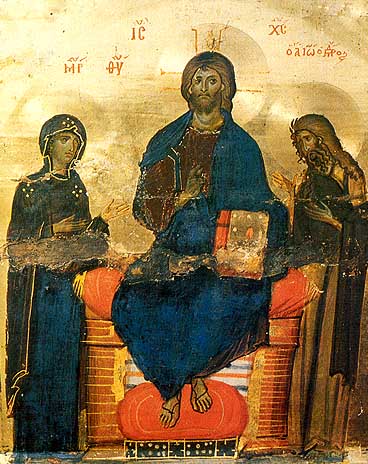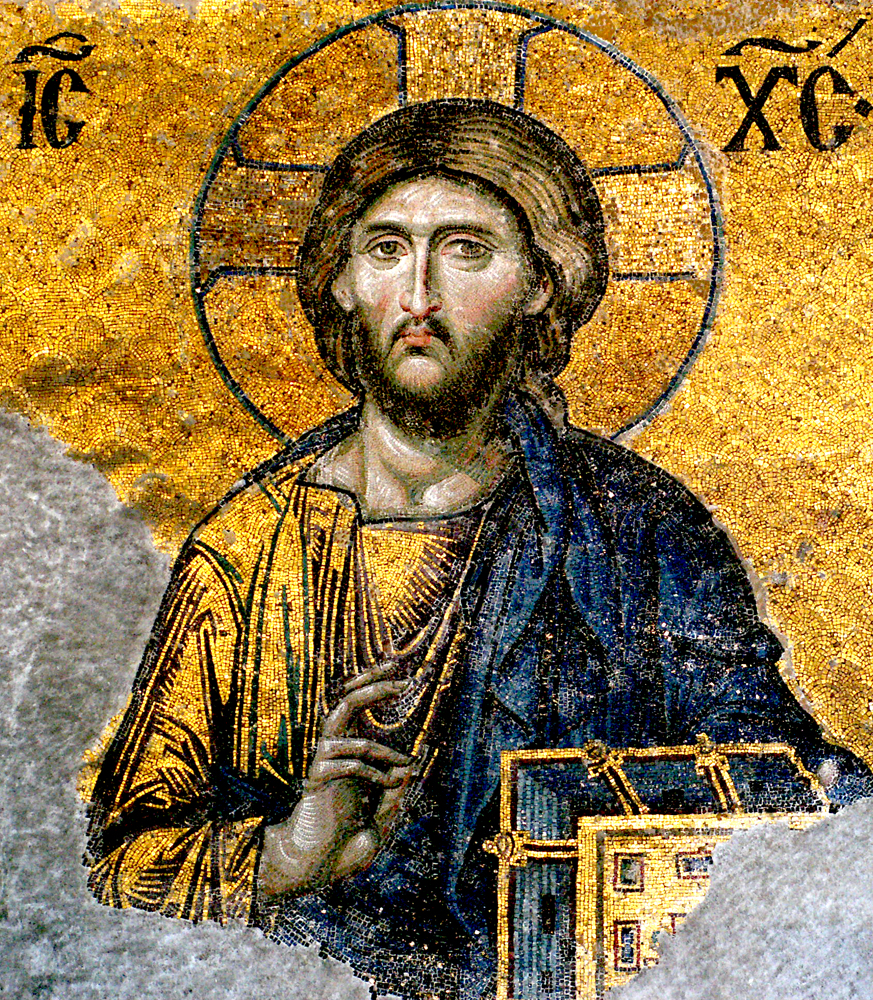|
Deesis
In Byzantine art, and in later Eastern Orthodox iconography generally, the Deësis or Deisis (, ; , "prayer" or "supplication") is a traditional iconic representation of Christ in Majesty or Christ Pantocrator: enthroned, carrying a book, and flanked by the Virgin Mary and St. John the Baptist, and sometimes other saints and angels. Mary and John, and any other figures, are shown facing towards Christ with their hands raised in supplication on behalf of humanity. Early examples often appeared on the templon beam in Orthodox churches or above doors, though icons and devotional ivories also feature the Deesis. After the development of the full iconostasis screen there was room for a larger "Deesis row" or "Great Deesis" of full-length figures, and the number of figures expanded, both in Byzantium and in Russia. Usually this row is above the level of the doors, and usually below (sometimes above) the row depicting the Twelve Great Feasts. The central Christ is therefore a ... [...More Info...] [...Related Items...] OR: [Wikipedia] [Google] [Baidu] |
Christ In Majesty
Christ in Majesty or Christ in Glory () is the Western Christian image of Christ seated on a throne as ruler of the world, always seen frontally in the centre of the composition, and often flanked by other sacred figures, whose membership changes over time and according to the context. The image develops from Early Christian art, as a depiction of the Heavenly throne as described in 1 Enoch, Daniel 7, and The Apocalypse of John. In the Byzantine world, the image developed slightly differently into the half-length Christ Pantocrator, "Christ, Ruler of All", a usually unaccompanied figure, and the Deesis, where a full-length enthroned Christ is entreated by Mary and St. John the Baptist, and often other figures. In the West, the evolving composition remains very consistent within each period until the Renaissance, and then remains important until the end of the Baroque, in which the image is ordinarily transported to the sky. Development From the latter part of the fourth cen ... [...More Info...] [...Related Items...] OR: [Wikipedia] [Google] [Baidu] |
Templon
A templon (from Greek language, Greek τέμπλον meaning "temple", plural ''templa'') is a feature of Byzantine architecture, Byzantine churches consisting of a barrier separating the nave from the chancel, sanctuary near the altar. The solid templon first appeared in Christian churches around the 5th century and is still found in many Eastern Christianity, Eastern Christian churches. Initially it was a low barrier probably not much different from the altar rails of many Western churches. It eventually evolved into the modern iconostasis, still found in Orthodox churches today. It is usually composed of carved wood or marble colonnettes supporting an architrave (a beam resting on top of columns). Three doors, a large central one and two smaller flanking ones, lead into the sanctuary. The templon did not originally obscure the view of the altar, but as time passed, icons were hung from the beams, curtains were placed in between the colonnettes, and the templon became more opaqu ... [...More Info...] [...Related Items...] OR: [Wikipedia] [Google] [Baidu] |
Iconostasis
In Eastern Christianity, an iconostasis () is a wall of icons and religious paintings, separating the nave from the sanctuary in a Church (building), church. ''Iconostasis'' also refers to a portable icon stand that can be placed anywhere within a church. The iconostasis evolved from the Byzantine architecture, Byzantine templon, a process complete by the 15th century. A direct comparison for the function of the main iconostasis can be made to the layout of the great Temple in Jerusalem. That Temple was designed with three parts. The holiest and inner-most portion was that where the Ark of the Covenant was kept. This portion, the Holy of Holies, was separated from the second larger part of the building's interior by a curtain, the parochet , "veil of the temple". Only the High Priest (Judaism), High Priest was allowed to enter the Holy of Holies. The third part was the entrance court. This architectural tradition for the two main parts can be seen carried forward in Christian ... [...More Info...] [...Related Items...] OR: [Wikipedia] [Google] [Baidu] |
Cathedral Of The Annunciation, Moscow
The Cathedral of the Annunciation () in Moscow is a Russian Orthodox Church, Russian Orthodox church (building), church dedicated to the Annunciation of the Theotokos. It is located on the southwest side of Cathedral Square, Moscow, Cathedral Square in the Moscow Kremlin in Russia, where it connects directly to the main building of the complex of the Grand Kremlin Palace, adjacent to the Palace of Facets. It was originally the personal chapel for the tsars, and its abbot remained a personal confessor of the House of Romanov, Russian royal family until the early 20th century. Now it also serves as a part of Moscow Kremlin Museums. History The Cathedral of the Annunciation was built by architects from Pskov in 1484-1489 as part of Grand Duke Ivan III of Russia, Ivan III's plans for a large-scale renovation of the Moscow Kremlin. Construction work began using the existing foundations in 1484 and was completed in August 1489. A number of the early 15th-century icons were re-used in ... [...More Info...] [...Related Items...] OR: [Wikipedia] [Google] [Baidu] |
Harbaville Triptych
The Harbaville Triptych () is a Byzantine ivory triptych of the middle of the 10th century with a Deesis and other saints, now in the Louvre. Traces of colouring can still be seen on some figures. It is regarded as the finest, and best-preserved, of the "Romanos group" of ivories from a workshop in Constantinople, probably closely connected with the Imperial Court. The group takes its name from the Romanos and Eudokia ivory plaque in the Cabinet des Médailles of the Bibliothèque nationale de France, Paris showing Christ crowning an Emperor, named as Romanos, and his Empress. This is thought to be either Romanos II, crowned in 959, or possibly Romanos IV, crowned in 1068. Related works are in Rome, the Vatican, and Moscow, this last another coronation probably datable to 944. Of this "Romanos group" the ''Harbaville Triptych'' is considered "by far the finest, for it shows an elegance and delicacy which are absent in the others. All are in the polished, elegant sty ... [...More Info...] [...Related Items...] OR: [Wikipedia] [Google] [Baidu] |
Last Judgement
The Last Judgment is a concept found across the Abrahamic religions and the '' Frashokereti'' of Zoroastrianism. Christianity considers the Second Coming of Jesus Christ to entail the final judgment by God of all people who have ever lived, resulting in the salvation of a few and the damnation of many. Some Christian denominations believe most people will be saved, some believe most people will be damned, and some believe the number of the saved and of the damned is unknown. The concept of the Last Judgment is found in all the canonical gospels, particularly in the Gospel of Matthew. The Christian tradition is also followed by Islam, where it is mentioned in many chapters of the Quran, according to some interpretations. The Last Judgment has inspired numerous artistic depictions, including painting, sculpture and evangelical work. In Judaism In Judaism, beliefs vary. Rosh HaShanah is sometimes referred to as a 'day of judgement', but it is not conceptualized as ''the'' Day ... [...More Info...] [...Related Items...] OR: [Wikipedia] [Google] [Baidu] |
Christ Pantocrator
In Christian iconography, Christ Pantocrator (, ) is a specific depiction of Christ. or , literally 'ruler of all', but usually translated as 'almighty' or 'all-powerful', is derived from one of many names of God in Judaism. The Pantokrator is largely an Eastern Orthodox, Eastern Catholic or Eastern Lutheran theological conception and is less common under that name in Latin Catholicism and Western Lutheranism. In the West, the equivalent image in art is known as Christ in Majesty, which developed a rather different iconography. ''Christ Pantocrator'' has come to suggest Christ as a benevolent, though also stern and all-powerful, judge of humanity. When the Hebrew Bible was translated into Greek as the Septuagint, ''Pantokrator'' was used both for ''YHWH Sabaoth'' () " Lord of Hosts" and for '' El Shaddai'' " God Almighty". In the New Testament, ''Pantokrator'' is used once by Paul () and nine times in the Book of Revelation: , , , , , , , , and . The references to God the F ... [...More Info...] [...Related Items...] OR: [Wikipedia] [Google] [Baidu] |
Andrei Rublev
Andrei Rublev (, ; ) was a Russian artist considered to be one of the greatest medieval Russian painters of Orthodox Christian icons and frescoes. He is revered as a saint in the Eastern Orthodox Church, and his feast day is 29 January. Early life Little information survives about his life; even where he was born is unknown. He probably lived in the Trinity-St. Sergius Lavra, near Moscow, under Nikon of Radonezh, who became hegumen after the death of Sergius of Radonezh in 1392. The first mention of Rublev is in 1405, when he decorated icons and frescos for the Cathedral of the Annunciation of the Moscow Kremlin, in company with Theophanes the Greek and Prokhor of Gorodets. His name was the last of the list of masters, as the junior both by rank and by age. Theophanes was an important Byzantine master, who moved to Russia and is considered to have trained Rublev. Career Chronicles tell us that together with Daniel Chorny he painted the Dormition Cathedral, Vladim ... [...More Info...] [...Related Items...] OR: [Wikipedia] [Google] [Baidu] |
Four Evangelists
In Christian tradition, the Four Evangelists are Matthew the Apostle, Matthew, Mark the Evangelist, Mark, Luke the Evangelist, Luke, and John the Evangelist, John, the authors attributed with the creation of the four canonical Gospel accounts. In the New Testament, they bear the following titles: the Gospel of Matthew; the Gospel of Mark; the Gospel of Luke; and the Gospel of John. Gospels The gospels of Gospel of Matthew, Matthew, Gospel of Mark, Mark, and Gospel of Luke, Luke are known as the Synoptic Gospels, because they include many of the same stories, often in the same sequence or even verbatim. While the periods to which the gospels are usually dated suggest otherwise, convention traditionally holds that the authors were two of the Twelve Apostles of Jesus, John and Matthew, as well as two "apostolic men", Mark and Luke, whom Orthodox Tradition records as members of the 70 Apostles (Luke 10): * Matthew the Evangelist, Matthew – a former tax collector (Levi) who w ... [...More Info...] [...Related Items...] OR: [Wikipedia] [Google] [Baidu] |
Louvre
The Louvre ( ), or the Louvre Museum ( ), is a national art museum in Paris, France, and one of the most famous museums in the world. It is located on the Rive Droite, Right Bank of the Seine in the city's 1st arrondissement of Paris, 1st arrondissement (district or ward) and home to some of the most Western canon, canonical works of Art of Europe, Western art, including the ''Mona Lisa,'' ''Venus de Milo,'' and ''Winged Victory''. The museum is housed in the Louvre Palace, originally built in the late 12th to 13th century under Philip II of France, Philip II. Remnants of the Medieval Louvre fortress are visible in the basement of the museum. Due to urban expansion, the fortress eventually lost its defensive function, and in 1546 Francis I of France, Francis I converted it into the primary residence of the French kings. The building was redesigned and extended many times to form the present Louvre Palace. In 1682, Louis XIV chose the Palace of Versailles for his househ ... [...More Info...] [...Related Items...] OR: [Wikipedia] [Google] [Baidu] |






